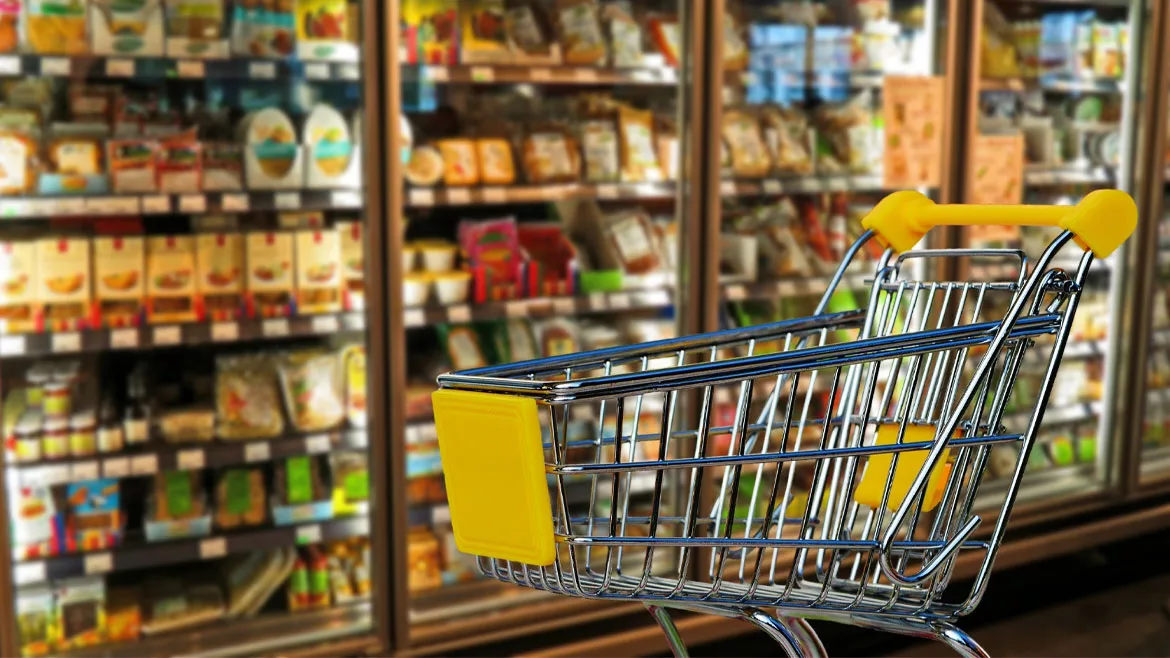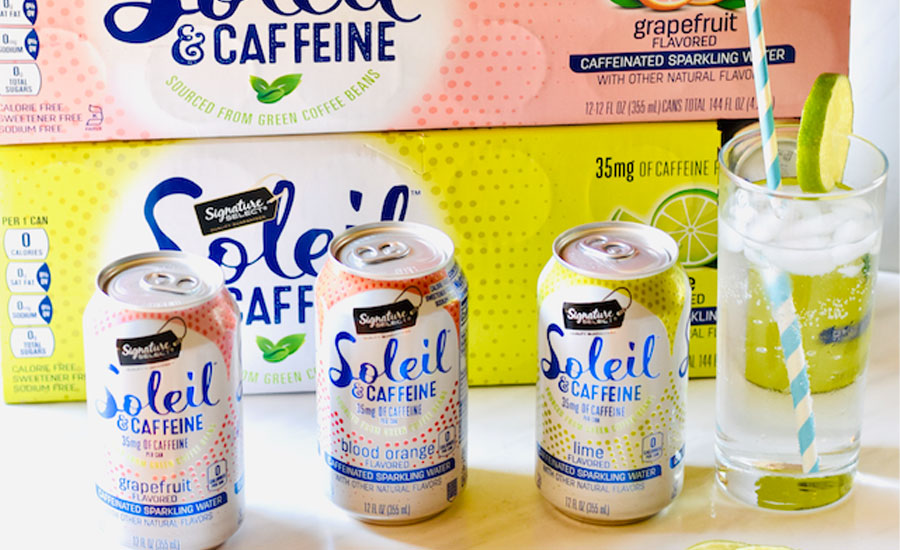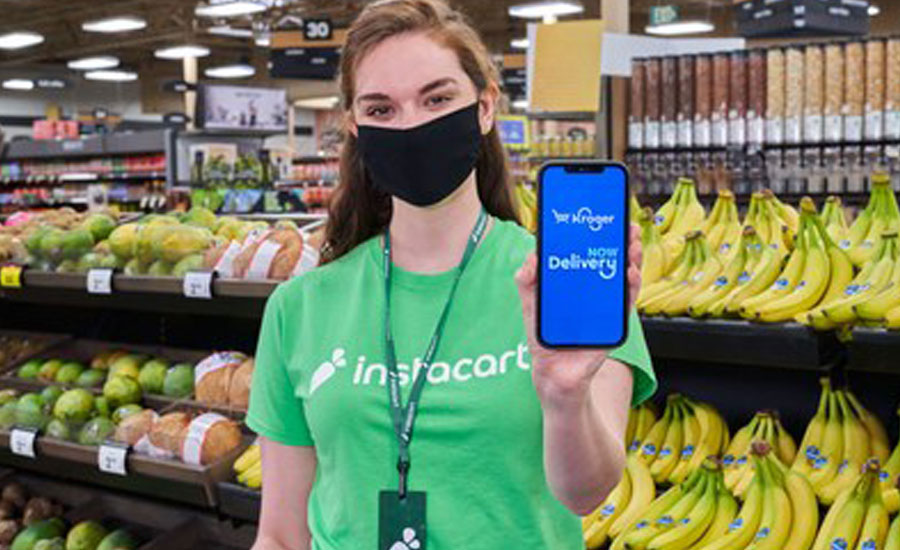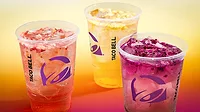Channel Strategies
Supermarkets turbocharge investments into digital technology
Consumers become more digitally engaged

Photo by Alexas_Fotos from Pixaby/courtesy of Canva
Legend has it that when seeing an apple fall to the ground, a young Isaac Newton realizes there must be some force pulling the apple toward the earth. Calling this force gravity, Newton describes its principles with a simple, memorable adage: “What goes up must come down.” Still, while the law of gravity bears Newton’s name, many of today’s physicists point to another Newton law as key: “Every action has an equal, opposite reaction.” At any rate, it seems either law applies to today’s grocery channel, as the COVID-19 pandemic led to a major shift in shopping habits.
In fact, Chicago-based Information Resources Inc. (IRI) data shows the grocery’s channel share to be 46.5% in October 2021, down from 49.1% in 2020. Meanwhile, channels gaining share include eCommerce and club.
“Grocery is losing share to other channels, in part because shoppers are feeling more comfortable shopping in stores,” says Joan Driggs, vice president of content and thought leadership at IRI. “We’re resuming some of our pre-pandemic shopping habits, often visiting multiple stores to fulfill our shopping list. At the depths of the pandemic, the preference was for a one-and-done shopping trip, which led many shoppers to the grocery channel.”
Further, 77% of shoppers reported in June that they “felt more relaxed shopping in-store” during their last visit; however, as of October 2021, 18% of shoppers reported spending less time shopping than they did for a similar trip before COVID-19, Driggs says.

Image courtesy of Safeway
Although nonessential businesses shutdown in 2020, consumers increased their expenditure on groceries as they stocked their pantries with food and other supplies, resulting in a boon for supermarkets across the country, says Dmitry Diment, senior analyst at New York-based IBISWorld.
“[Restaurants] were impacted heavily by social-distancing orders and remained closed in main areas significantly longer than other businesses did. Consumers also benefited from the influx of cash and other government assistance delivered via the large coronavirus spending bills passed at the federal level during the Trump and Biden administrations,” Diment explains. “In 2020 alone, revenue rose an estimated 10.2%.”
Meanwhile, eCommerce had a significant disruptive effect on the industry, forcing the industry’s largest players to rapidly adapt, Diment says.
“Many supermarket operators shifted to omnichannel offerings to remain competitive with ‘eTailers,’ such as Amazon.com Inc.,” he explains. “This trend is expected to continue over the next five years, as overall eCommerce sales are expected to rise, indicating a continued shift toward virtual shopping.”
As spending less time in-store diminishes the opportunity for shoppers to discover new products or brands, it also takes away the amount of time grocers have to provide an “experience” that shoppers value in-store, such as demonstrations and sampling, experts note.
However, the supermarket channel has transformed during the past year into a physical and digital experience for consumers. For instance, the development of curbside and delivery have helped create more loyal customers, larger baskets and a more connected, personalized shopping experience, says Leah Logan, vice president of social commerce and retail media at Inmar Intelligence, Winston-Salem, N.C.
“While global events like the COVID-19 pandemic force consumer behavior into a flux state, habits and practices form foundations that outlast the catalyst itself,” Logan says. “The consumer experience faced an early evolution thanks to the pandemic, pushing some channels, technologies and tactics to the forefront.”
As consumers are interested in using a variety of technologies or implementations that make shopping easier for them, only a small percentage of shoppers say that they are “not interested” in using digital features, and almost a third are not yet using but are interested, Logan adds.
“All the rest are either using or open to using eCommerce and social commerce tools,” she explains. “Modern shoppers are always looking for ways to blend digital and physical shopping and expect retailers to make changes that provide that ‘phygital’ convenience.”

Image courtesy of The Kroger Co.
Ever-growing selections
Beyond technology advancements, supermarkets continue to balance the diversified shopping carts of today’s consumers. As shoppers are encouraged to try new brands as a result of ever-growing selections, brand loyalty now occurs when a favorite is discovered, but only until a new option of interest appears, Inmar’s Logan notes.
“The most obvious effect of SKU proliferation has been a progressive loss of brand loyalty,” she explains. “Tied to this explorative loss of loyalty is a new consumer awareness of the shopper’s power to control the market. Shoppers are becoming aware of their ability to select what most appeals to them, and the resulting impact of their buying decisions. This means stronger data related to interest and purchase behavior, but also a need for brands to pivot quickly to meet trends head-on.”
Additionally, with the growing number of SKUs comes more options that align with specific health objectives, and shoppers are responding well to the variety in this space, Logan says.
“Brewed and fermented beverages have had a wonderful time in grocery stores recently. This includes options like cold-brewed coffee, kombucha, teas and the alcoholic versions of each,” she explains. “This trend echoes recent shopper interest in convenience — consumers are starting to prefer the ease of pre-prepared beverages over brewing at home.”
Previously reserved for high-end distribution channels, these beverages now line the shelves of middle-market locations as consumer preferences have continued to skew toward healthier options, IBISWorld’s Diment adds.
“Kombucha and cold-brew coffee, among others, have increasingly become a staple at supermarkets, '' he says. “Indeed, many of these neo-traditional beverages benefited from the spike in consumer spending at grocery stores since the outset of the pandemic.”
IRI’s Driggs notes that while dollar sales of ready-to-drink (RTD) cold-brewed coffee are up 17.6% from a year ago (YA) (2020), refrigerated RTD coffees are up 42% in dollar sales.
“I think the message with beverages is that as more adults commute to work (we know that more Americans will continue to work at home at least some of the time versus pre-pandemic), sales of conveniently packaged drinks will increase,” Driggs says. “For example, sales of coffee for home-consumption, think pods, instant and ground coffee, really took off during the pandemic because people were not visiting coffee shops. Some of this behavior will continue — not all, because again, more of us will continue to work from home some of the time, but many will resume their pre-COVID-19 behaviors.
“Similarly, and this is a generalization because we don’t track sales of vitamin-fortified beverages as a separate subcategory, we know that consumers really upped their self-care regimens during the pandemic, with sales of vitamins and minerals showing very strong growth,” she continues. “Beverages have always been a great carrier for nutrition, so it makes sense to assume that sales of fortified beverages will increase as we’re more mobile, but also as we continue to focus on health and wellness.”
Digital, physical blends
As newer online channels have improved capability to deliver groceries quickly and leverage lower operating costs into lower prices, grocery stores are looking to lure consumers into stores by increasing spending on advertising, investing in digital technology and leveraging scale to deliver lower prices, IBISWorld’s Diment says.
“The proliferation of eCommerce, coupled with the contagious nature of the coronavirus pandemic, has caused many supermarkets to turbocharge their investment into digital technology,'' he explains. “Large chains have rushed to roll out online shopping options for pickup and delivery, as well as mobile apps that consumers can use to simplify and speed up their in-store experience.”
Moreover, as retailers have heavily invested in eCommerce solutions throughout the pandemic, annual reports are full of eCommerce growth of more than 100% for many retailers. Now, as part of the eCommerce experience is a digital experience, retailers need to make shopping as easy/seamless as possible, experts note.
IRI’s Driggs suggests that while sales of fresh items online is still a hurdle, many consumers have been happy having someone else pick their bananas or select meat for them. Additionally, as nonedible items always have done well through eCommerce, it is a great solution for repeat replenishment or even subscription.
“We see lots of partnerships with companies like Instacart, either for fulfillment and delivery, or even just delivery,” Driggs says. “Click and collect, however, is the most popular fulfilment type, especially through the grocery channel. Consumers like the flexibility of naming the time they can pick up their items, how they’re loading directly to the car, and even the extra accommodations/parking spaces retailers are providing for easy pick-up.”
Additionally, with shoppers spending less time in-store, more discovery will take place online. One of the best investments brands and retailers can make now is in search, according to IRI’s Driggs.
“If you don’t show up when the shopper is looking, you won’t make it into the shopping basket,” Driggs says. “Especially with the high incidence of out-of-stocks, now is the time to show up and be the next best ― and maybe the next permanent ― choice.
“Essentially, it’s in every retailer’s best interest to showcase their point of differentiation, whether it’s high quality, low prices, unique assortment, convenience of shopping, great shopping experience, rewards or another level of service,” she continues. “And we know that the vast majority of consumers are digitally engaged, so digital engagement makes the most sense.”
Looking for a reprint of this article?
From high-res PDFs to custom plaques, order your copy today!






